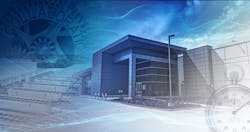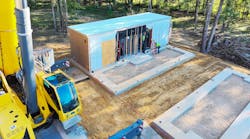Case Study: When a Hyperscaler’s Ambitious Vision Calls for Hundreds of Megawatts of New Capacity in Under 18 Months
This is a true story. About how the hyperscale tech company’s data center team was able to deliver the capacity needed to support the ambitious vision. Even in an unprecedented environment with pressure on both demand and supply sides. And not just a little capacity – over 40 megawatts of dedicated data center capacity built and commissioned in 16 months, nearly a year faster than market average. (The first 27 megawatts was ready in just 13 months.)
The Challenge: Unprecedented demand + Constrained supply = 24-month average time to market
While COVID-19 represented a huge step up in demand, accelerating growth has continued and today massive demand is the new normal. The global datasphere – a measure of all the data created, captured, replicated, and consumed in a given year – is forecasted to nearly triple between 2021 and 2026. That massive demand is reflective of technology innovations like artificial intelligence, which has applications in every facet of the economy. For most of us, AI is a good thing, but it has fundamentally changed the approach to building and buying data center capacity.
Three years of unprecedented demand has eaten up most hyperscalers’ existing data center inventory, and most third-party providers’ off-the-shelf inventory too. In the first quarter of 2023, the average vacancy rate of the top 10 North American data center markets was 2.88% according to datacenterHawk, down from 8.3% just a year earlier. Globally, twenty-four markets are now under 10% vacancy, according to Cushman & Wakefield, compared to just six markets in 2020. Both hyperscalers and third-party developers have been building, of course, but demand has been so massive, on top of supply chain constraints, that most new capacity gets absorbed before it’s even commissioned.
At the same time, supply chains for infrastructure like generators, chillers, UPSs, and switchgear remain incredibly tight – and getting worse, according to a recent survey by Uptime Institute. Where in the past lead times might have been 8-10 weeks and warehouses might have been full of backup supply, now most developers have exhausted their backup supplies and are proactively ordering MEP equipment two years ahead. Supply chain constraints affect hyperscalers for their own builds just as they affect third-party providers, and savvy developers are adopting new approaches accordingly.
Facing these challenges of unprecedented demand and constrained supply, the hyperscale tech company’s data center team approached Stream Data Centers.
“We need Stream to help us manage this convergence of the greatest demand and the lowest supply chain availability that we've ever seen.”
Hyperscale Customer
The Solution: Flexibility, collaboration, and trust
The market dynamics of unprecedented demand and constrained supply made life very difficult for the hyperscaler’s data center team trying to deliver the hundreds of megawatts of new data center capacity required to achieve the company’s ambitious new vision. With supply chain delays extending build times beyond two years and vacancy rates at record lows, the customer was hard-pressed to build or buy their way out.
In this kind of environment it is the agile companies – whatever their size and purchasing power – that win.
- Flexibility – In a perfect world, uniformity is beautiful. Standardized data center deployments enable hyperscalers to keep cost down, availability up, and boost speed to market. In an imperfect world, you can get the capacity you need, on time, if you’re willing to be flexible. That doesn’t mean compromising on table stakes like reliability, supportability or sustainability that are essential to support the company’s mission; it does mean being open to new approaches as long as the table stakes are met.
- Collaboration – One of the realities that often slows down projects within large companies is competing agendas. (For example, the design team wants things one way and the site selection team wants them another.) There was no time for that if the hyperscale tech company was going to realize the ambitious vision. Agreement about the priorities led to concerted action between teams – theirs, and ours. We were all aligned on the company’s vision and were committed to working through the details to realize it.
- Trust – In today’s environment every day brings a new challenge and a new exception to ‘the way we usually do things.’ Success requires people with the expertise and experience necessary to navigate challenges as they come up, prioritize, and make decisions. People sometimes say that familiarity breeds contempt, but in this case, it breeds efficiency and speed. The Stream Data Centers team includes industry veterans with decades of experience at hyperscale tech companies. That shared history bred trust, and enabled more efficient communication and quicker decision making.
“Just wanted to drop you a line to share with your delivery teams. Our Design, Network and Construction teams said in review that Stream was one of the best landlords they worked with.”
Hyperscale Customer
The Result: Working together, Stream and the customer brought over 40 megawatts of dedicated data center capacity online in 16 months
Even in this unprecedented environment with pressure on both demand and supply sides, Stream was able to get the customer over 40 megawatts of dedicated data center capacity built and commissioned eight months faster than the current market average – enabling the company’s ambitious new vision and its share of a multi-trillion dollar opportunity.
We can’t take all the credit, of course. The hyperscale tech company’s data center team was smart, empowered, internally aligned, willing to be flexible, to adjust internal processes, and to trust. All easier said than done, so kudos to their team.
The experience makes the customer, and Stream, better for what comes next. We are comfortable with high degrees of transparency and collaboration. Sharing good news and bad news, exchanging ideas, and relying on smart people to power quick and accurate decisions. Market circumstances have forced even tighter collaboration and greater degrees of flexibility and we’re going to continue to work that way, positioning us to lead in what comes next.
And what comes next? It’s likely that supply chain constraints will begin to ease. But demand will continue to rise at an increasingly rapid pace. Growing investments in new technologies – in particular, the increasing use of artificial intelligence, which represents a sea change from the technology developments that came before – will fuel ever-increasing demand for capacity.
This is the new normal. We’re ready for it and so are our customers.
Tejo Pydipati is Senior Vice President of Design & Construction at Stream Data Centers, which builds and operates for large and sophisticated hyperscalers and enterprises – 24 data centers since 1999, with 90% of our capacity leased to the Fortune 100. Read a more in-depth version of this story in Stream’s latest case study: How Stream Delivered Over 40 MW of Dedicated Data Center Capacity in 16 Months for a Hyperscale Tech Company With an Ambitious Vision.



